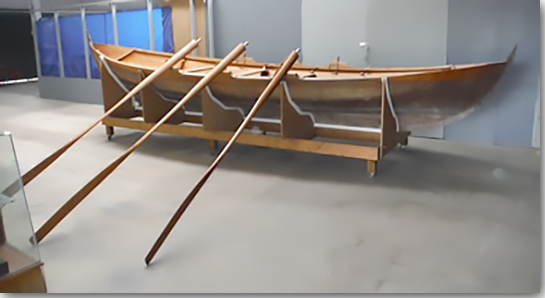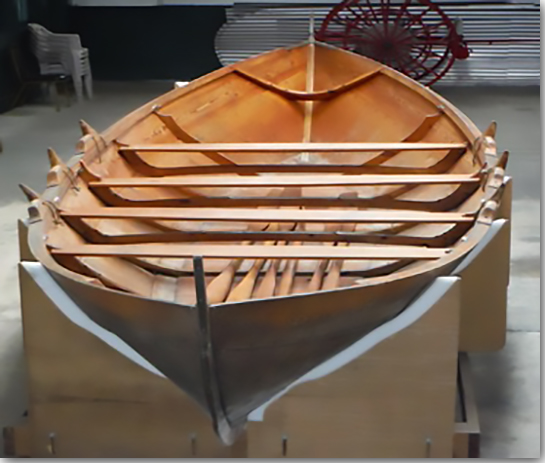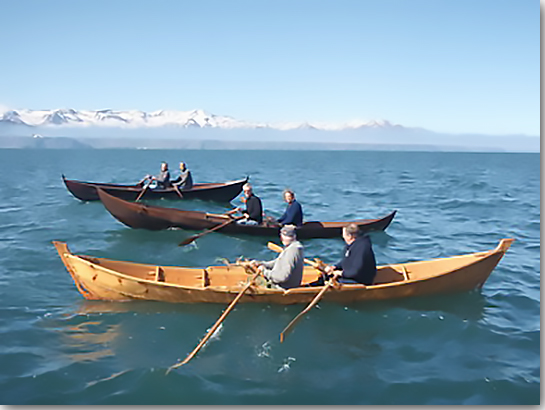Norwegian Oselvar Analysis by Emma Hildebrand

Oselvar starboard side, with three of its six oars resting on the ground. (Boat owned by the Museum of Underwater Archaeology; photo courtesy the MUA)
The oselvar is a small clinker-built boat propelled by either oars or sails that originated in Norway and has a history that spans a few thousand years. The oselvar pictured here is propelled by six oars and was built by renowned Norwegian boat builder, Harald Dalland for ceremonial use in the 1996 Olympics. Dalland crafted the 22 feet and 10-inch-long boat out of oak and pine and with traditional tools and techniques, such as with a “boat yell” – a meter-length wooden stick that is etched with all the necessary measurements used to build an oselvar.
This oselvar is a standard width of just over six feet, which enables the boat to be very well balanced and to carry a considerable amount of weight when on the water. The boat is held together with iron rivet fasteners – traditional for the oselvar. The stem post of the boat is covered in a thin layer of sheet metal to protect the vessel from unruly and rocky Norwegian seas.

The inside of the fully constructed oselvar has four benches and visible frames. (Boat owned by the Museum of Underwater Archaeology; photo courtesy the MUA)
The oselvar was first built in the Norwegian municipality of Os in Hordaland where most of the land is woven between small rivers and ocean inlets. Though the original oselvar is believed to have appeared around 300 C.E.., the name "oselvar" came about in the 1750s when the boat was crafted at the mouth of the Oselva River by two brothers who are credited as being the fathers of the oselvar craft, Lars and Jørgen Tøsdal. From these two, the trade can be traced through history as it was passed down from fathers to sons.
The boat has long been used by farmers, fishers, and townspeople to travel around the region and transport goods because of its practical and sturdy construction that can bear the weight of a family, farm-grown crops, and even livestock. The boat reached peak popularity in the mid-nineteenth century and began to be sold around coastal Norway in the form of boat kits. Customers would receive a box with the prepared equipment and would be able to build the simple boat themselves. Soon after its booming period, the oselvar was rendered useless by paved roads and bridges, modern boats, and new shipping technologies.

Oselvar boats are frequently raced by oar in Os, Norway in an ode to Norwegian tradition. (Photo credit: Oselvar Boat - Reframing a Traditional Learning Process of Building and Use to a Modern Context. UNESCO Register of Best Safeguarding Practices. Os, Norway, 2016. https://ich.unesco.org/en/lists.)
Though the oselvar’s everyday use has been rendered unnecessary due to modern technology, the boat is still celebrated as a fundamental part of Os, Norway’s maritime culture. After the mid-1900s, the traditional workboat began to be used for leisure and racing throughout coastal Hordaland. Since 1978, the Norwegian Championship has been held where twenty or more oselvars race in a regulated sailing regatta. Despite the uptick in oselvar races, demand was still so low that the number of craftsmen equipped to build the boat decreased.
Throughout the 1950s-70s the oselvar practice faced a state of emergency. In 1997, the only two living builders trained in the oselvar craft started “Oselvarverkstaden” or “The Oselvar Workshop” – a shop in Os that recruits, trains, and hires boat rites to build the oselvar boat with traditional methods. Oselvarverkstaden’s work has been recognized by UNESCO for keeping the oselvar construction tradition alive and spreading historical knowledge to new generations. The workshop’s educational efforts have also kept the oselvar’s history prevalent through an annual “Oselvar Festival” that celebrates the boat that has carried the region through rough seas for generations.
Previous







